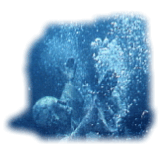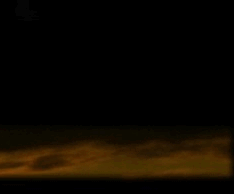|
To debunk popular discourse on a topic is not to investigate it. To cut off branches is not to kill the tree. For decades I have investigated a wide range of popular mysteries. I have searched for the instigating kernel and if finding it traced where it leads. Sensationalism develops a real topic in ways completely false, and those who then scoff and debunk it only scoff and debunk theories that arose in the minds of sensationalists and opportunists. The original mystery remains silent and untouched.
The Philadelphia Experiment probably fits into that scenario. As noted in previous pages, every Allende annotation in M.K. Jessup’s paperback edition of The Case for the UFO has some basis in occult scenarios, each finding repeat cycling in Fate Magazine, a very popular tabloid in the 1950s. Interspersed here and there are brief allusions there was a Navy experiment in 1943 that proved Einstein’s Unified Field Theory. Implicitly this is provided as proof of UFO motive power, that doorways to other worlds can be manipulated, and it validates Edgar Cayce’s readings speaking of a fantastic power used by ancient Atlantis, the time apparently Genesis is referring to when Moses said the sons of God came down and mated with the daughters of men and their progeny were mighty men, men of renown— a favorite verse for the occult.
Carl Meredith Allen was a crackpot, and Jessup knew it. But Jessup also knew Fate Magazine and the occult quite well too. He saw Allende’s twisted use of occult stories, and no doubt thought the same applied to his claim of some secret wartime experiment. Allende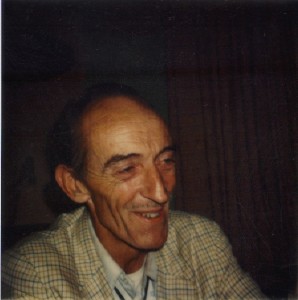 was less a hoaxer and more of a crank, with his simple self-important mind trying to draw attention to a reality he ultimately thought was there. was less a hoaxer and more of a crank, with his simple self-important mind trying to draw attention to a reality he ultimately thought was there.
A color photo of Allende in later life (credit unknown).
Those who have taken a middle line on the Philadelphia Experiment have suggested there were tests done to protect a ship against magnetic mines. Therefore some degausers may have been used to see if they could be fitted along the hull and could repel such mines. There may have been some astonishing and unexpected side effects. These side effects may have inspired other non related experiments. There is a Project Rainbow codename in the list of wartime experiments, a name that could have been inspired by a corona effect on an earlier test.
That no other crewman ever came forward to give corroborating testimony to the slim basis of Allende’s claim is probably because he so embellished it to adorn his occult world no other crewman could recognize what he was talking about. If some did, their outlets would have been the “sensationalists” who wouldn’t be eager to pass along the truth of a mundane test with some exciting light effects.
We can’t take it as significant that it can be proved the USS Eldridge was not in Philadelphia in October 1943. Carlos Allende, for what it’s worth, never said the Eldridge was the destroyer subjected to the “Philadelphia Experiment.” The only time he mentioned a ship’s name, it was his merchant vessel the Andrew S. Furuseth, and he implied he and another crewman Chief Mate “Mosley” were the object of the test.
Let’s put context to this, one of Allen’s few annotations regarding an experiment. Jessup is writing about a colonial tale which he customarily accepted on face value. It was the story of a sailing ship seen floating in air off New York. The account had been written by C.F. Talman, and it is from him that Jessup recounted the story. Talman suggested it had been a mirage. But Jessup:
“Nothing was said about the image being upside down, which is a usual characteristic of mirages. And if so close as to make every spar recognizable, would not this be pretty close for a mirage? And, again, are mirages commonly noted right after a storm? Aren’t they more likely in a time of stable weather when stratification of the atmosphere over water and land is possible?
It is entirely within the realm of possibility that this ship was seen in the process of being levitated!”
By a UFO, of course. Allende had underlined the above. Then he annotated:
Tried that with Mosley & I on Board Furnseth and he XXXXXX was drunk enough to slip out of the “Freeze” & He Made them know it in No uncertain terms. They put us down & Then unfroze the crew who to this day Do Not remember of it. THEY CAN’T. (Mr. M. was Chief Mate, “Hatteras” 1943)
Perhaps they detected “FIELD” Activity of Navy D-E WHICH WAS CLOSE BY, (BEFORE) TESTING AN INVISIBILITY EXPERIMENTAL “gadget.”
It is ambiguous as to what ship is the subject of the test. Three ships are mentioned, two by name. Levitation is a big thing to the occult, and Jessup’s hang up was gravity. So, once again, Allende used the hook of claiming an actual scientific experiment proved levitation can be accomplished by Einstein’s Unified Field Theory.
For argument’s sake, presuming the Philadelphia Experiment was based on some kernel of truth, it would make sense that the Navy would use a merchant vessel, not a valuable destroyer, to see if it could be made to repel magnetic mines.
One thing we can be certain about, the tests did not involve a harnessing of Einstein’s Unified Field Theory. He had withdrawn the thesis for a good reason. As he set it forth it is not possible. Gravity was considered a force back then. Since an electric current generated a magnetic field at a right angle, and because there are three planes of space, gravity was postulated to be found in relationship to electromagnetism. Today gravity is classified as a “phenomenon.” This means it is the byproduct of more than one other factor— the bending of space, mass, etc. It would take a massive vortex to affect gravity.
It is also not too significant that Carl Allen popped up at the offices of APRO in Arizona in 1969 and retracted the entire Philadelphia Experiment story. Brad Steiger had been making some waves on the subject, at least within the esoteric crowd, and Allende was 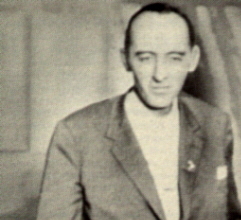 tired of people profiting, as he seemed to regard it, off his story. It was around this time he was trying to huckster money out of Jacques Vallée, as we saw in the previous page. Short on money, as always, Allen seemed to want to cash-in and when that failed over 1968 he turned to ruining the gravy train of others. tired of people profiting, as he seemed to regard it, off his story. It was around this time he was trying to huckster money out of Jacques Vallée, as we saw in the previous page. Short on money, as always, Allen seemed to want to cash-in and when that failed over 1968 he turned to ruining the gravy train of others.
APRO’s famous photo of Allende in their office, 1969. Coral Lorenzen was a fairly careful operator. Esoterica had written up Allende as a mystery man of dubious reality, an alias for a far more potentially powerful person.
Like always with retractors of popular stories, they retract the retraction and continue to peddle the story. It is the same here. So what is the truth? And what is Allende’s value to the whole story?
As noted in the previous pages, Allende’s annotations in the Varo copy are ramblings. Without his letters to Jessup, there is no focal point, probably why ONR published the letters within the annotated Varo edition.
When they wrote their foreword and declared their justification— “Because of the importance which we attach to the possibility of discovering clues to the nature of gravity, no possible item, however disreputable from the point of view of classical science, should be overlooked”— they weren’t referring to the annotations, they were delicately referring to Jessup’s work. Jessup had a thesis. The annotations do not. But one annotation may have convinced the Office of Naval Research the thesis was worthy of being examined. In the long rambling conclusion at the end of the book, there is this paragraph:
The Good Doctor
Is far more aware of Committing the Cardinal effrontery of Unorthodoxy than he wishes to show, perhaps. Too He wishes to have More & More & More, a flood of Data, & facts & Records of observations that will back-up his Theory. It would seem Much More apropo were he to not ask for further Proof to show to his fellow Professional Deriders but Were He To Proceed Himself into the only field that would convince each and Every one of His fellows; That field of Gravity & Magnetic exploration, as yet Untouched, He THEN could say the Moon is Hollow & Not one person would say a Word. Approach to Morals & Ethics of Science, Not New. Newton proved His Theory throo observable phenomena The which anyone could observe & So Has this Man.
I reiterate the final words & So Has this Man. ONR wanted this cycled within its core group of scientists to see if Jessup’s data, his ramshackle collection of oddities and enigmas, could shed light on harnessing gravity. The Allende Letters had mentioned scientists’ names, and Allende even called a “Franklin Reno” his friend. Perhaps one of the annotators did have firsthand contact to some old test and these annotations should be perused as well?
However surprising it may be to readers today, the psychic, especially as it pertained to the new phenomenon of UFOs, was pursued even by Office of Naval Intelligence (ONI) and the CIA. Colonel Robert Friend told of a story that had happened when he was head of Project Blue Book. He got pulled into the CIA and told how an Admiral’s neighbor was getting psychic messages. Two ONI officers visited her and then later engaged in a séance in 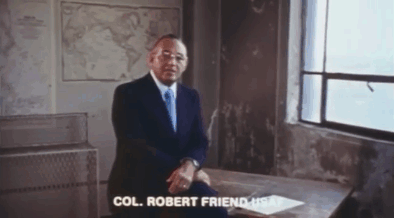 the CIA’s photographic analysis department (located over the old Stuart Motor Car Dealership in Washington DC) and a sensitive Naval officer went into a trance and alien entities started communicating. the CIA’s photographic analysis department (located over the old Stuart Motor Car Dealership in Washington DC) and a sensitive Naval officer went into a trance and alien entities started communicating.
Robert Friend, now a civilian, recreated the encounter for UFOs: It Has Began in 1974.
W. Todd Zeschel was a former NSA (National Security Agency) agent turned to investigating UFOs in the 1970s. He uncovered the names. It had been Admiral Robinson and his neighbor was Mrs. Gray Swan.
In sum, ONR was more likely to be even more open-minded. They might have thought there could be some psychic influence in some of the annotations. Certainly those involved (3 annotators were thought to be at work) knew of the occult. Jessup would have been receptive to this avenue as well.
In order to get ourselves unstuck from the Freeze of the legend, we have to dash away “Jessup the scientist” and replace him with the reality— Jessup the adventurer and seeker. His academic training was first in archeology and then only later astronomy. As a student, he was already on archaeologic digs in Guatemala and Nicaragua. Immigration passports confirm this as early as 1921. Adventure lured again with the chance to explore the Amazon, so he tagged along as photographer in 1923 to seek out rubber with an impressive group of U of Michigan’s botanists under the auspices of Henry Ford. Instead of pursuing archeology, he was a natural with astronomy and got his BS in this, then his MS. But most of his time was spent teaching at Drake University. At his daughter’s birth in 1933, he lists 8 years at his current profession teaching math and astronomy. He tried to get a Ph.D in astrophysics, but apparently never went through his final dissertation. He may have seen it would only lock him into a dull academic position. In all his time at teaching he only had one sponsored trip abroad, and this was in 1930 to be part of a team operating the largest telescope in the southern hemisphere near Johannesburg, South Africa. On the way home, he stopped off in Peru and potted about the Inca ruins. Immigration again confirmed it. With his wife, he board the Ginyo Maru at Callao and headed to Los Angles. The South African trip had been sponsored by the Detroit Observatory, and that is listed as his address.
A few years after his daughter’s birth and that was it for Jessup and academia. He activated old contacts with rubber and his beloved South America and got into tire manufacturing. I suspect it allowed him to travel and pot about ruins. The Case for the UFO shows he had already accepted much about Edgar Cayce’s readings, disposed to do so from his own investigations of Peru. Some of the blocks at Tiahuanaco were just too big to have been moved into place by human engineering. The science/occult fringe had been suspecting Tiahuanaco and ancient Egypt were colonies of ancient Atlantis. Even adventurer and explorer Percy Fawcett used psychic “psychometrising” of objects to lead him to believe his City of Z was a fabulous remnant of a past super-civilization. From his personal examination of Inca dwellings, he felt certain they had electricity in prehistoric times.
Jessup would have known all this and have been disposed toward psychic avenues long before he admitted to being in “Critical Receptivity.” But he was stuck in an academic position that did not allow him to indulge his craving for discovery. Tire manufacturing didn’t get him there, for WW II soon dawned. He was absorbed into the Murray Corp. of America in Detroit, which was providing specialized equipment for the war.
As with much of Jessup’s life, the next steps are cloudy, and these steps take him from Detroit to a little two story brick house in the suburbs of Washington DC and to being an “executive in export service.” His publisher padded his scientific standing, and those within the saucer world were anxious for educated participants. They were glad to call him “Dr. Jessup.” But he really was an adventurous von Daniken long before the counterculture made such a person and his views popularly acceptable.
UFOs ruined Jessup. He had been glad to accept ancient human civilizations had been quite advanced and Cayce’s Atlantis had a basis in reality. He had tangible ruins to support a level of psychic intuition. But the advent of UFOs added an unexpected dynamic. He didn’t believe they came from another planet. He knew the vast distances of space. Thus his work concentrated on history. He was subtly making a case UFOs were a leftover of ancient Earth, as his amateur archeological studies had imposed upon him.
In the end Jessup was not a scientist, nor had he been much of one for 20 years. He had chosen the wrong major and should have remained in archeology. His export business allowed him to travel to his beloved South America, and he continued to pot about ruins. Now with believing in UFOs he would seek out natural oddities to explore. These, like the craters in Mexico, would confirm UFOs could be miles in diameter and were based near Earth— a remnant of our prehistoric super past. He spiraled more and more into psychic help, into non material explanations. His belief in ancient Atlantis and Tiahuanaco predisposed him to do so, and he went all the way.
It would be astronomically unlikely that M.K. Jessup did not inquire of Mark Probert and his “12 Controls” through his growing friendship with Meade Layne, the director of Borderland in California, for answers to the Allende annotations. The overwhelming likelihood that Jessup gave his re-annotated copy to Layne (see previous page) is reflected in Vincent Gaddis (who lived near to Borderland) admitting (in 1965 already) he had seen Jessup’s re-annotated copy. The context was in reference to Layne’s successor Riley Crabb’s work on Jessup’s fate.
M.K. Jessup was, to put it politely, a nut. Colloquial categorizing states that a nut has wild ideas about one subject whereas a crank has them about many. Jessup certainly had wild ideas about UFOs, explaining each fantastic mystery residing in occult lore as caused by them.
Jessup was seriously inquiring of “excarnate astronomer Ramon Natalli” through Mark Probert and Layne for a complete law for the development of the solar system, something to surpass Bode-Titius. I would find it hard to believe he did not earlier inquire of Probert about the truth of the Philadelphia Experiment and the annotations in his paperback book, especially the repeat ones to Atlantis and UFOs arising from the sea and in our human past.
One can also see the basis of his friendship with J. Manson Valentine, psychic and oceanographer, and adherent to Cayce’s Atlantis. One, however, can also see why Valentine should wish to present his friend as a purely materialist scientist. Disappearance of ships and planes are a tangible reality, and you cannot base your cutting edge quantum physics theory on a dead man who was engrossed in the occult.
I respect a true believer in whatever pursuit they follow, and someone who quests is to be admired. One who inspires quests should also be respected. However, when they start invoking the psychic as a source unto itself, they’ve not cast anchor, they have cut it. J. Manson Valentine knew this was a mainstream attitude, and I believe he tailored his account of Jessup accordingly. Nevertheless, he was a true believer in questing for explanations of the supernatural and UFOs. In the back of his mind, Charles Berlitz too believed and therefore was willing to be a conduit intriguing his readers with the potential, even sometimes if he had to accentuate little inconsistencies and mysteries or, also, place the right narration on the wrong example. Before his fame with The Bermuda Triangle in 1974, he had devoted much (financially unrewarding) time to Atlantis.
I have also never been so disconcerted in my life except by true believers.
Faith does not have to pivot on religion. Things unexplained are often approached by people seeking, and they hold many tenets; most they picked up from experience along the way of the quest. These come together to form a powerful faith system with which they partially tackle each new step in an old quest or with which they begin a new one. From experience, hope, and faith, they have formed their own cross-reference for vetting information.
J. Manson Valentine, of an age and class, could afford to affect the status of the shrewd doctor in Cat People or the discriminating character embodied in Quatermass. Berlitz, too, was of such a world. Both were Yale. Both were affluent. Poor Jessup was not. He was Indiana. He was outside his league with such a world where Valentine could spontaneously go into a trance. He had to work many angles. His shadowy export business, his books, lectures, and I’m not sure what else.
This had been Jessup as far back as the 1930s when he critically followed the occult (Cayce) regarding stories of the ancient past. Perhaps this even helped cause a breach between he and his academic peers. During the era of his UFO fame, there are too many holes in his past, and a lot of them concern his career. When he told Gray Barker that U of Michigan dropped its interest in backing an expedition to examine the Mexican craters, he said it was because they found out a “UFO researcher” was involved. U of Michigan knew Jessup personally. In such a case, I doubt their response would have been so anodyne.
Investigating UFOs had originally been an “insulated business,” as he put it. It was a tangible adjunct to his very passionate examination of a tangible Atlantean past. Edgar Cayce’s readings helped give clarity and direction. Psychics should be able to do the same thing with UFOs. But he was wrong. Many psychics were now peddling a new religion and New Age philosophy through alien contact, none of which could have a tangible cross reference like ancient South American ruins.
He should have kept his pursuit a purely physicalist’s one. But he didn’t. He clearly confused himself by privately requesting and being in a state of “critical receptivity” of the non material world.
Ray Palmer made it all convenient. He was the publisher of Fate Magazine. It debuted in 1948 with a UFO cover and became a popular tabloid, mingling the occult with the latest reports and examinations of the UFO phenomenon. It is to Fate that Jessup turned to find the latest reports of mysteries and read a reexamination of old mysteries. He would not have done so if he had not been disposed already through his use of Edgar Cayce.
It’s not surprising that he and Valentine were friends. Valentine was a bridge between both worlds— the trance, ESP and psychic world that Duke University routinely investigated— and the physical world in which apparently UFOs came and went somehow. Cutting edge physics were naturally of interest to both, and this meant Einstein and theories of time warps and electromagnetic energy.
Both also had a very superficial approach to research. They believed in popular renditions and stories and collated this to build their dossiers of evidence off which to theorize, even inspire and temper their own quests. I tend to think this was Valentine’s level of knowledge on the Philadelphia Experiment, that is to say, he knew what Steiger, Crabb, and Barker had compiled and mixed this with some fairly superficial discussions with Jessup.
Valentine’s theories on the Bermuda Triangle parallel Jessup’s ideas of intelligence controlled fogs, vapors, and UFOs kidnapping people. We can also see the parallels in the Philadelphia Experiment, in which electromagnetic energy is said to have shrouded the vessel in a greenish mist, similar to reports in the Triangle, according to Valentine and Berlitz. Thus these mists may be concealing UFOs within and the mists are created by the craft’s novel 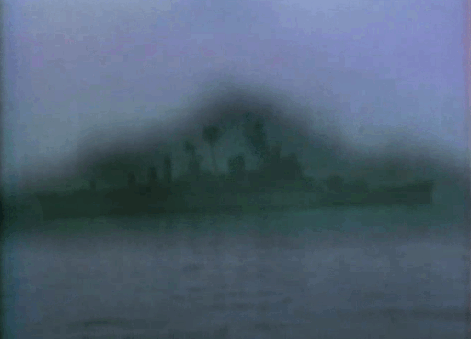 electromagnetic propulsion systems. The PE was very real and necessary for Valentine, but it was the PE of legend and nothing Jessup had learned through secret investigation. electromagnetic propulsion systems. The PE was very real and necessary for Valentine, but it was the PE of legend and nothing Jessup had learned through secret investigation.
The Philadelphia Experiment dramatically recreated in Sunn Schick Classic’s tabloid docudrama in 1979.
UFOs and mists do happen in the Triangle. I have the account from two reliable yachtsmen, Paul Vance and Doug Gerdon, who describe it here. It is a question of interpreting the cause of such phenomena. Then, of course, how far can we take it in theory.
The same can be said over the facts surrounding the Philadelphia Experiment legend. Jessup’s death is a fact. But where does it lead? The legend of murder was incubating in the 1960s— the height of the antiestablishment movement when any authority was considered to have been capable of anything nefarious. It is Valentine who accepted nothing but bad vibes from arcane publications and then hooked millions with the potential Jessup was murdered.
I find it hard to believe Jessup “discovered too much,” as his methodology was not capable of discovering too much. He had no qualifications in advanced physics. I don’t think he was depressed by academic criticism either. He hadn’t held an academic position for a long time. He was disturbed by failure and more than confused about life. He was now divorced. He had been in a car accident.
Jessup’s death does have oddities to it. I don’t believe he had a garage at his house back then. Therefore it might seem reasonable that he went to a public park to gas himself. However, doing so in the day is quite odd. Sunset was not until an hour later (after he was found at 6:30 p.m.) This may explain the rumor he was still alive when found. Someone must have recognized the car rigged with a hose from the tailpipe to the window. Matheson Hammock, where he went, is a pretty vast park with some pretty secluded parking areas, however.
To promote that Jessup was worthy of assassination is ludicrous, at least when it comes to the motive it was fear his “advanced” ideas had to be stopped. His sources were Fate Magazine and then taking such Americana folklore stories as true and explaining them via UFOs.
Jessup’s 1954 article for The Saucerian on “UFOs and the Moon” also shows he was a quack. Tag line “Astronomers have seen the UFO in space” stokes our interest! In part:
The sightings were documented more than 80 years ago. Documented, and measures made. By triangulation their habitat has been disclosed and their parent ships identified. Something is known of their size and nature.
They are a part of the Earth-Moon system. Beware the smokescreen belched forth by Army Ordnance and Dr. Tombaugh who SAY they are looking for small satellites circling the Earth. There is a place where they can look and with likely success -- and, they are NOT satellites. Strangely enough, these "things" are just about the right size to fit into a nice big cradle, or crater, such as the one on the Arizona Plateau, and which would just be visible to an Astronomer on the Moon if he possessed a modest sized telescope.
Further:
In Mexico there is a group of ten craters similar to the Arizona Crater and of just the same size and appearance as the small craters on the Moon. These are recorded on Aerial films hoarded by the Airforce, and restricted. They are "classified" and YOU cannot obtain prints of them. Does Ordnance connect these with the "Satellites" which they wish you to believe that they and Tombaugh are looking for? Who knows?
The article naturally implied there was a connection. He had clarified to Barker: “The Mexican craters are real— I found them myself, and I’ve seen the airforce negatives.”
Probably, Jessup had seen the negatives first, by hook or freak. As always if possible he detoured during one of his “exporter” trips to South America to find them afterward. If we are to believe Citadel Press’ promo of The Case for the UFO (1955), Jessup had “discovered” them recently.
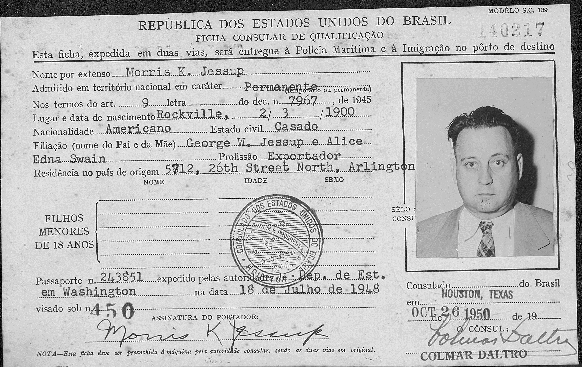
Stamped October 1950, this is the passport Jessup was probably using when he sidetracked to Mexico to check out the craters close-up.
It is virtually impossible Jessup discovered them, but he did find them. In 1956, his hopes of examining them in detail almost seemed fulfilled. A commercial enterprise was going to take him in order to search for minerals under the craters. Then, perhaps, even the government would sponsor a full scale investigation through U of Michigan. The proposed trek was rejected when U of Michigan discovered a UFO researcher was involved, at least that was Jessup’s excuse to Barker. The commercial enterprise was really Jessup’s last hope. I assume they believed he had discovered the craters and therefore was crucial to any financially minded venture. Gray Barker wrote: “Some people believe that the falling through of these plans is a link in a chain of disappointments that led to suicide. It is indeed true that a lot of the author’s hoped-for success never materialized.”
We see the similarity in the Mexican craters to the Philadelphia Experiment. These craters were tangible proof, Jessup believed, of huge UFOs landings on Earth at some ancient time. He was always looking for “proof.” He also probably believed some tests could be done to indicate residual effects if a gravity drive have been used. He always believed ultimate proof to everything lay in uncovering UFO motive power. No doubt, he could then understand how Tiahuanaco was built.
Jessup protected their location. But it wasn’t hard to find them today. In The Case for the UFO, he admitted Manzanillo, Mexico, was “a tropical pesthole, if ever I saw one” and his book promoted his field to include: “Mr. Jessup’s latest explorations have taken him to the high plateau of Mexico where he has discovered an extensive group of craters. They are as large as, and similar to, the mysterious lunar craters Linne and Hyginus N, and he believes them to have been made by objects from space.” Going inland from Manzanillo and up to the high plateau, one comes to Valle de Santiago, a small town next to a crater. It is one of 8 craters (at my count), many of the others called Hoya (pit) like Hoya de Cintora, Hoya de Alvarez, Hoya de Estrada, etc. They are hardly remote. It was certainly far less developed back then, but I cannot believed Jessup discovered them.
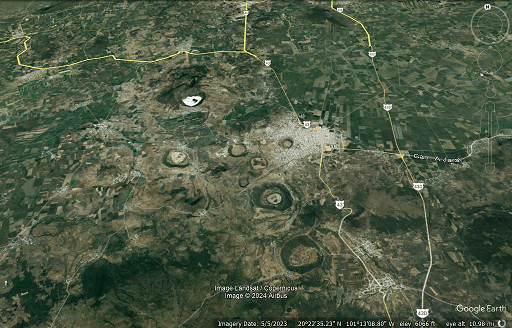
Jessup’s craters, developed with farmland inside them or tourist viewing points. Valle de Santiago is built up around one, and little villages are dotted about the others.
Certainly 80 or 90 years ago, Valle de Santiago was a rustic little town and the villages of today wide spots in the roads. But the hoyas were well known. I’m no geologist, but they look more volcanic than meteoric. Dozens of little “seamounts” dot the countryside from Manzanillo up to the craters, another sign of past volcanic action. It looks like Challenger’s Lost World.
In any case, I can see why the commercial enterprise dropped the expedition. A little research would tell them where these craters are and they wouldn’t need Jessup to lead them. Valuable gemstones can be found under impact craters, but there is some question here. Then, on top of it, their guide really believes they were made by UFOs— so he clearly can’t believe there are minerals under them. Yet it seems Morris Jessup was ready to do anything to get an expedition funded. He would examine them as UFO landing spots and the commercial geologists could check if these could be impact craters.
There is, nevertheless, far too much vagueness in Jessup’s promoted background. How did an astronomer who attempted to get a Ph.D in astrophysics get funded to search for rubber in the Amazon (once), funded to investigate Inca pyramids, and pot about Mexico to claim he found a grouping of well known hoyas? Certainly unqualified for examining them all, he must nevertheless have been very charming to get the funding. He was no doubt looking the whole time for proof of ancient aliens without declaring it. Hmm. Maybe.
. . .Well, we already know he was only the photographer in the 1923 Ford rubber expedition. It didn’t take much digging to uncover the context of his other excavations. I’ve already touched on Jessup’s youth, but it is best to explore it a bit more.
From a very early age, Jessup was interested in a wide variety of topics. Fawcett’s adventures (and eventual disappearance) in South America, and a prehistoric super-civilization that needed rediscovery. His request for a passport in December 1921 lists him as a student. His reason for wanting to leave the port of New Orleans? “Research in Archeology.” So as a student of 21, he went abroad (on a Fruit Co steamer name as-yet-unknown on his application) and left on January 21, 1922, to Guatemala and Nicaragua. I’m guessing a bit now, but decades later 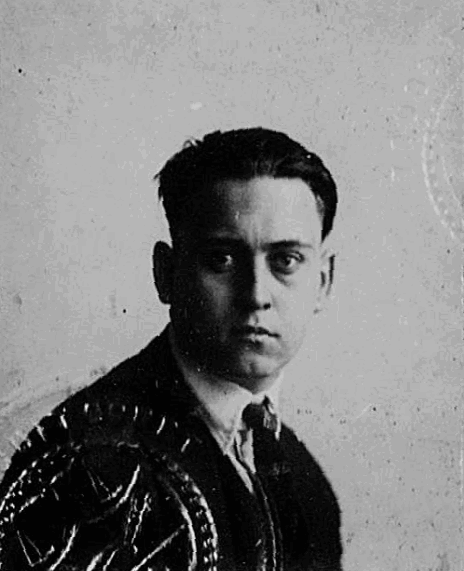 when he started to explore UFOs, he recalled this youthful trip and came to his new theory about Mayan buildings. At the time, however, he had been just a snot nose student doing grunt work. when he started to explore UFOs, he recalled this youthful trip and came to his new theory about Mayan buildings. At the time, however, he had been just a snot nose student doing grunt work.
M.K. Jessup passport photo, young and serious.
In 1923 he jumped at the chance to explore Brazil when U of Michigan went under the auspices of Henry Ford to look for rubber. He was but a photographer, but that was enough for his publisher to promote he searched for rubber at the headwaters of the Amazon. He returned from Para, Brazil, on the s.s. Benedict to New York in November 1923. He returned to the dull life of academia and strangely did not pursue archeology. Yet he continued to travel. Immigration recorded him a few times, once with his wife Kathryn. They entered Los Angeles in December 1930, sailing on the Ginyo Maru from Callao. As I understand the paperwork, they originally came from Johannesburg, South Africa. His place of work is listed as Detroit Observatory, Ann Arbor, Michigan. This does support the claim he operated the largest refracting telescope in the southern hemisphere, though I doubt at 30 years old he was actually in charge of the observatory, despite the publisher’s inference. Callao is in Peru, so perhaps they had stopped there for a while . . .and it is now he personally potted about/examined Tiahuanaco and the Inca pyramids on his own. Citadel Press does say it was a private organized expedition. A tourist trip is private.
I’m not knocking it. We’ve all done it, and a serious quester should be encouraged to do it. But these cannot be given the color of funded, scientifically endorsed expeditions.
Brazil yet again issued a passport and in 1950 he got it stamped in Houston, Texas. South America and Mexico certainly fascinated Jessup. He is listed as an exporter. He seems now a 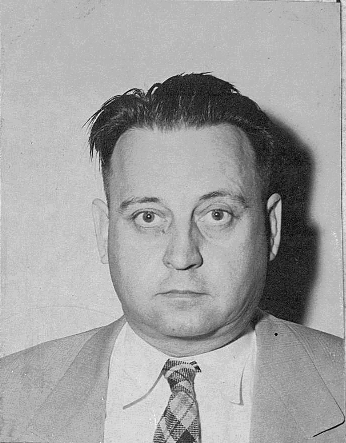 portly, somewhat lost soul. portly, somewhat lost soul.
M.K. Jessup in 1948-1950 during the time of his Brazilian passport.
Even on his death certificate, his ex-wife Kathryn did not provide his father and mother’s names. (George Wilford Jessup and Alice Edna Swain).This was odd to Gray Barker, but they had been divorced in 1956 and she remained in Arlington, Virginia, and he moved to Florida. She was probably on the phone with the coroner.
I assume this move didn’t interfere with his “exporter service” business, whatever that means, and certainly wouldn’t interfere with his trips to Central and South America. As noted earlier, it is this passport he must have been traveling under when he visited Mexico to hunt down the craters he saw in restricted US Air Force photos.
He is, at least, a very curious soul. Had he lived to reach the 1970s, his books would have been republished and he would have been hailed as the original von Daniken. He would have enjoyed some elder statesman attention, but I think it would have been the real Jessup— not the “scientist” of 1950s promotion, but the seeker and amateur adventurer looking into the past.
Unfortunately, Jessup’s death freezes him in space and time, a time when he is a bit too mysterious. I wonder if he was not a CIA contact. He would be briefed before his travels. He would debrief his CIA Control upon return. It sounds very exotic, but it is really equivalent to being a dollar-a-year man for those who travel a lot and have an academic background. They mix with an interesting crowd and as such are in the environment to pick up information. Writing books on UFOs wouldn’t interfere with this. The CIA’s attitude is, information is where you get it. And there are slight slips in the story of the Philadelphia Experiment. I doubt ONR would have called him in to show him the annotated book unless they knew he had already been security cleared. They knew he hadn’t held any respected academic position for years. There simply was no reason to invite him unless they knew he had a double life.
By temperament, Jessup certainly fit. Somewhat of a contemporary, Peter Tompkins was both a reporter for the New York Herald Tribune and a secret OSS agent— Office of Strategic Services— during World War II, precursor to the CIA. He, too, was a heavy duty believer in Cayce’s Atlantis and believed the Egyptians levitated the stones into place to build the pyramids. This “science” was lost because Alexander the Great killed the priests with the knowledge. He frequently used psychics to get information. His popular books Secrets of the Great Pyramid and Mysteries of the Mexican Pyramids reveal his storehouse of psychic methodology. They are pillars of 1970s open-mindedness. Had Jessup lived to the 1970s, he would have reveled in them.
Those like Tompkins who held respectable mainstream positions and quietly doubled in Intelligence gathering never really feared too much the after-affects of establishment criticism when they went boisterously public with their occult journeys. I don’t think Jessup would have either. I doubt the fear of criticism had anything to do with his suicide. But Jessup was also trying to get rich.
He truly was Erich von Daniken decades before a von Daniken could be popular. Decades after von Daniken’s fame, he could admit the extent he had to huckster his way to visit the world sights he wanted. It seems Jessup had to do the same. He might have crossed the line in trying to get his first true expedition funded.
I induce that it is possible he discovered the “Mexican craters” in the early 1920s and by the 1950s didn’t realize to what extent their locations were known, perhaps why the commercial enterprise dropped him. The book promo claims it was recent but, good Lord, there was nothing secretive about them then. But I digress.
Or do I? Was he using them to huckster an expedition? Had he been advanced money? Did the commercial enterprise find out that any tourist could stumbled upon these now? Did he really believe or was he trying to pay bills?
He said he had seen the restricted intelligence photos, and so it may have indeed been recent that he found them, but his comment about Manzanillo is tailored from the 1920s and not 1950s. His book doesn’t elaborate on personal experiences. Certainly, it would have proved interesting reading how he made it to the area of Valle de Santiago for a preliminary search anyway.
Valentine had promoted Jessup’s academic career, like the publisher’s promo. Yet any astronomy background was truly irrelevant to the content of The Case for the UFO and Jessup’s truest and greatest desire to discover the origins of mankind and civilization. He was a restless, searching soul. This is certainly true. The real Jessup is actually far more interesting than the hard scientist the legend required to explain a scientific basis for the Bermuda Triangle.
But there is a darker side, one only hinted at.
Valentine probably would not have faulted Jessup’s research methods. They were similar to his own— purely personal. He had reports of missing ships and planes, UFOs, fogs, electromagnetic vapors, and a friend like Jessup who promoted a link between them all. Then his friend had mentioned a fan who went beyond his strange letters and contacted the Navy elaborating on this secret experiment. That was probably enough for Valentine. This is the story he gave us. Because of the Triangle’s popularity, Berlitz’s book sold millions. Everybody wanted to know about the mysterious death of M.K. Jessup. But few tried to uncover his life.
In the end we are left with something that was never investigated. It has been puffed up and bloated with the yeast of hope and speculation, opportunism and debunkery.
|

